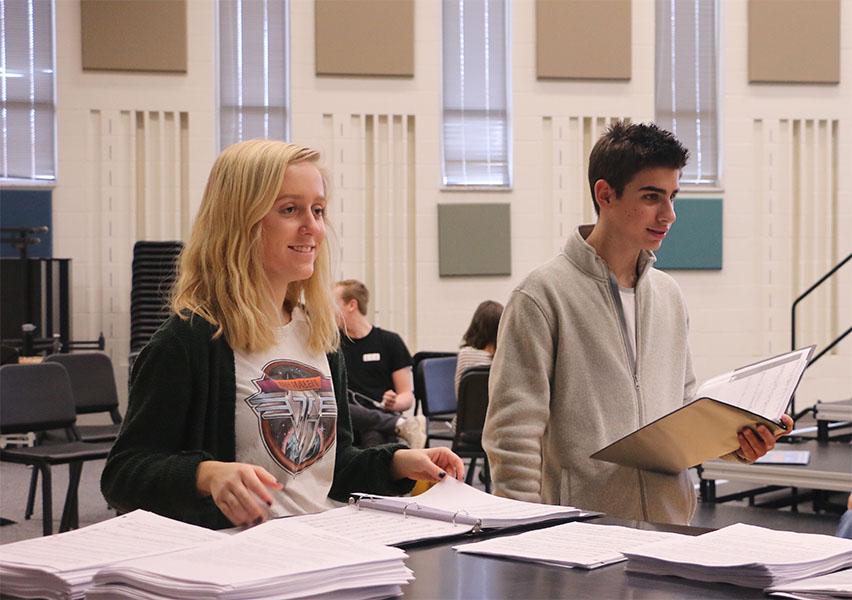Gender bending within theater has been a common practice since the ancient times and is mostly associated with roles written by William Shakespeare. Back then, having a typically female role played by a male actor only occurred because it was not seen as acceptable for women to act in any kind of play. But, while men playing women is common in theater, women playing men is normally a rare occurrence, especially in professional productions. This year’s CHS production of “Peter and the Starcatcher” may change that notion.

The cast of “Peter and the Starcatcher” map out the scenes of the play at a blocking rehearsal. Actors casted in the play include five female actors who play male roles.
Junior Sophia Hughes plays the role of Bill Slank in “Peter and the StarCatcher.” Since there were only two original female roles in the production, Hughes said it was best for her to audition for a male role. It’s not her first experience either; she’s played male roles before, such as the Beast in
“Beauty and the Beast,” Gregory in “Romeo and Juliet” and a gangster in “The Drowsy Chaperone.”
“Definitely male roles, all the time,” Hughes said regarding her acting preferences. “They’re just more challenging to me, I think, and a lot of times female characters are very stereotypical and very bland because they’re usually written to not know what’s going on. Whereas male roles, more times they’re funny and I just always find them more fun to play.”

Junior Piper Dafforn vocally rehearses for “Peter and the Starcatcher.” Dafforn was casted as the male role of Smee.
Junior Piper Dafforn, who plays the role of Smee, also said male roles tend to be written funnier than female roles.
“I’m a lot more comedic than I am serious, (and) there’s rarely funny girls in shows,” Dafforn said. “A lot of times if there’s a comedic part, it’s a guy. A lot of times when girls are funny, they’re more annoying and it’s more classic for the funny one to be a guy.”
It’s difficult to find a production with several female roles, according to director Maggie Cassidy. She said at the high school level, gender-bending roles becomes more common based on availability of female actors to play them.
“There were plenty of boys that I didn’t end up casting. Other shows, it can be tricky, but for this one, it wasn’t a struggle, no,” Cassidy said. “I would never have chosen this show if it was 12 actors: 11 boys and one girl. With the opportunity to be able to cast anyone and gender-bend, that made this show much more interesting and possible for me to do.”
Dafforn said gender-bending has become increasingly common in theater.

“I think [gender-bending roles in theater are] more common than we’d expect. Especially in live theater,” Dafforn said. “It’s definitely becoming more common, which I like because it’s another element to the show. People are more okay with it. It’s not as weird anymore. Sometimes people are more weirded out by it, but I think more people are coming to terms with it and realizing it can be entertaining.”
Still, in professional theater, roles played by the opposite sex are more rare unless productions find them to be necessary.
“I think in theater, they don’t do (gender-bending) very much on Broadway because they have so many talented actors and actresses to play those roles, and we would be so limited on our options for high school if we didn’t gender-bend,” Cassidy said.
Hughes said gender-bending should not be frowned upon because the gender of an actor is irrelevant when they are playing a role.
She said, “I think it should be taken as a more acceptable thing by directors simply because the audience won’t view that person as being someone playing an opposite gender, they’ll view them as a character based on whether or not they’re good enough.”
“Peter and the Starcatcher” performances will be in the Dale E. Graham auditorium from Feb. 8 to Feb. 11 at 7 p.m. with another 2 p.m. showing on Feb. 11.

































![AI in films like "The Brutalist" is convenient, but shouldn’t take priority [opinion]](https://hilite.org/wp-content/uploads/2025/02/catherine-cover-1200x471.jpg)









































![Review: “The Immortal Soul Salvage Yard:” A criminally underrated poetry collection [MUSE]](https://hilite.org/wp-content/uploads/2025/03/71cju6TvqmL._AC_UF10001000_QL80_.jpg)
![Review: "Dog Man" is Unapologetically Chaotic [MUSE]](https://hilite.org/wp-content/uploads/2025/03/dogman-1200x700.jpg)
![Review: "Ne Zha 2": The WeChat family reunion I didn’t know I needed [MUSE]](https://hilite.org/wp-content/uploads/2025/03/unnamed-4.png)
![Review in Print: Maripaz Villar brings a delightfully unique style to the world of WEBTOON [MUSE]](https://hilite.org/wp-content/uploads/2023/12/maripazcover-1200x960.jpg)
![Review: “The Sword of Kaigen” is a masterpiece [MUSE]](https://hilite.org/wp-content/uploads/2023/11/Screenshot-2023-11-26-201051.png)
![Review: Gateron Oil Kings, great linear switches, okay price [MUSE]](https://hilite.org/wp-content/uploads/2023/11/Screenshot-2023-11-26-200553.png)
![Review: “A Haunting in Venice” is a significant improvement from other Agatha Christie adaptations [MUSE]](https://hilite.org/wp-content/uploads/2023/11/e7ee2938a6d422669771bce6d8088521.jpg)
![Review: A Thanksgiving story from elementary school, still just as interesting [MUSE]](https://hilite.org/wp-content/uploads/2023/11/Screenshot-2023-11-26-195514-987x1200.png)
![Review: "When I Fly Towards You", cute, uplifting youth drama [MUSE]](https://hilite.org/wp-content/uploads/2023/09/When-I-Fly-Towards-You-Chinese-drama.png)
![Postcards from Muse: Hawaii Travel Diary [MUSE]](https://hilite.org/wp-content/uploads/2023/09/My-project-1-1200x1200.jpg)
![Review: "Ladybug & Cat Noir: The Movie," departure from original show [MUSE]](https://hilite.org/wp-content/uploads/2023/09/Ladybug__Cat_Noir_-_The_Movie_poster.jpg)
![Review in Print: "Hidden Love" is the cute, uplifting drama everyone needs [MUSE]](https://hilite.org/wp-content/uploads/2023/09/hiddenlovecover-e1693597208225-1030x1200.png)
![Review in Print: "Heartstopper" is the heartwarming queer romance we all need [MUSE]](https://hilite.org/wp-content/uploads/2023/08/museheartstoppercover-1200x654.png)




